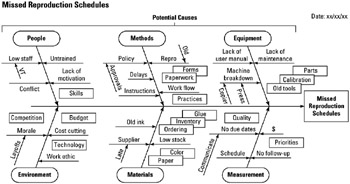Tool 26: Cause and Effect Diagram Adding Cards (CEDAC)
| AKA | Bulletin Board Fishbone |
| Classification | Analyzing/Trending (AT) |
Tool description
Developed and first introduced in 1978 by Sumitomo Electric Industries of Japan, the cause and effect diagram adding cards (CEDAC) is a fishbone diagram that typically displays major, generic categories such as people, methods, materials, equipment, measurement, and environment that cause an effect, often perceived as a problem. This diagram is used to systematically analyze cause and effect relationships and to identify potential root causes of a problem. An additional feature of adding cards by those outside the team allows the capture of more ideas from others in an expanded involvement in the problem-solving process. Once the basic diagram is completed and posted, cards or notes indicating more causes or ideas are attached.
Typical application
-
To assist a team in reaching a common understanding of a complex problem and to share this information with others for more input.
-
To expand the team's thinking and to consider all potential causes.
-
To post and share a completed cause and effect diagram (CED) for the purpose of allowing others to add potential causes or ideas.
-
To define the major categories or sources of root causes.
-
To organize and analyze relationships and interactive factors.
-
To identify factors that could improve a process.
Problem-solving phase
| → | Select and define problem or opportunity |
| → | Identify and analyze causes or potential change |
| Develop and plan possible solutions or change | |
| Implement and evaluate solution or change | |
| Measure and report solution or change results | |
| Recognize and reward team efforts |
Typically used by
| Research/statistics | |
| Creativity/innovation | |
| Engineering | |
| Project management | |
| 3 | Manufacturing |
| Marketing/sales | |
| Administration/documentation | |
| 2 | Servicing/support |
| 4 | Customer/quality metrics |
| 1 | Change management |
before
-
Cause and Effect Diagram (CED)
-
Brainstorming
-
Brainwriting Pool
-
6-3-5 Method
-
Five Ways
after
-
Problem Specification
-
Work Flow Analysis (WFA)
-
Process Analysis
-
Countermeasures Matrix
-
Pareto Chart
Notes and key points
-
This tool is an expansion of the cause and effect diagram (CED).
-
Generic category designations may be substituted. Example: Procedures for methods, or facilities for requirement, etc.
-
Do not overload categories. Establish another category if more detail is desired.
Step-by-step procedure
-
STEP 1 Reach consensus on a problem to be analyzed. See example Missed Reproduction Schedules.
-
STEP 2 Determine the major categories and place one in each category box.
-
STEP 3 Brainstorm possible causes for each category and enter in a fishbone fashion by drawing arrows to the main arrow (category), as shown in the example.
-
STEP 4 Continue to ask questions using the Five Whys tool to search for root causes. Insert and connect potential causes to the various other contributing factors.
-
STEP 5 When the team feels that the diagram is complete, a final and much larger diagram is drawn.
-
STEP 6 The diagram is posted in a hallway or on bulletin boards with an invitation for others to examine and possibly add their causes or ideas on available cards or Post-its to the respective categories on the diagram.
-
STEP 7 After a specified period of time, the diagram is removed and revised to include the additional information. A completed, smaller diagram is reposted with a thank you note.
-
STEP 8 The team now advances to the next step of further analysis, additional data collection, and problem solving.
Example of tool application

EAN: 2147483647
Pages: 326